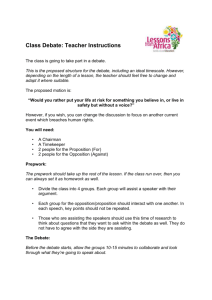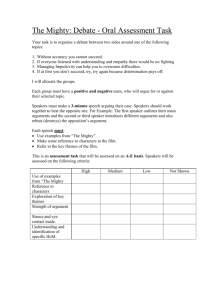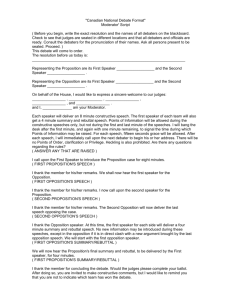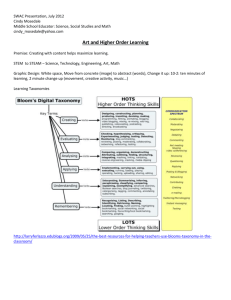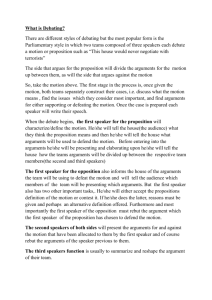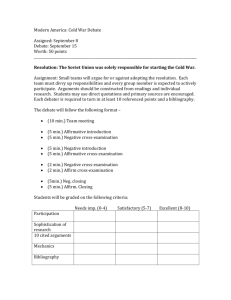The Modern World Debates, 2010
advertisement
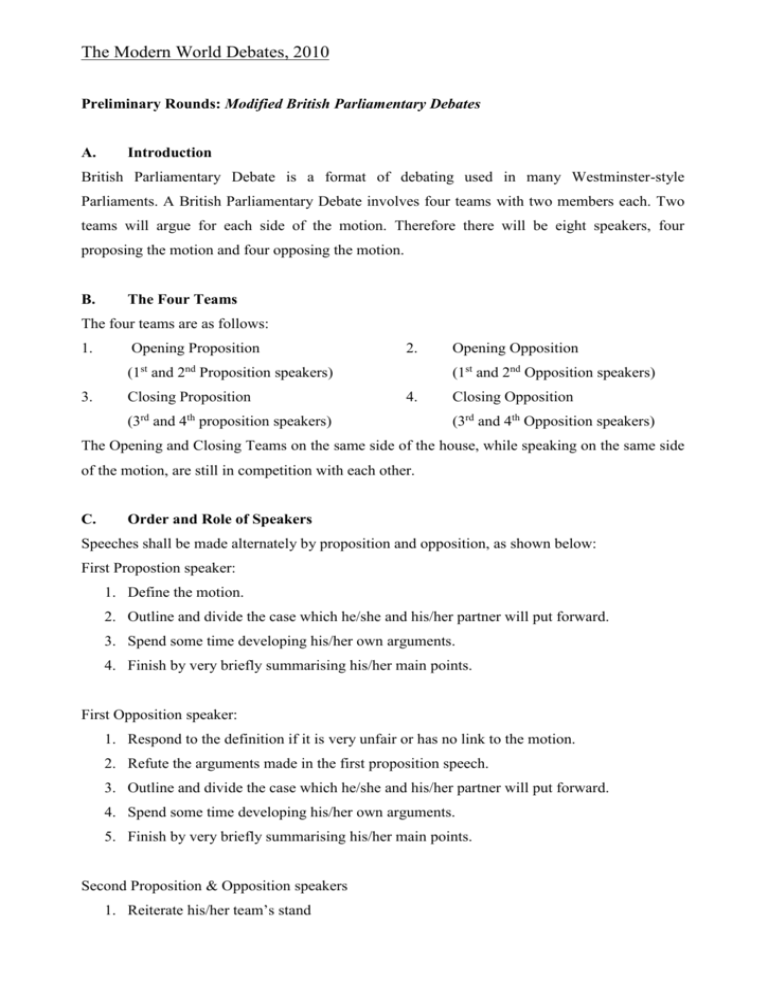
The Modern World Debates, 2010 Preliminary Rounds: Modified British Parliamentary Debates A. Introduction British Parliamentary Debate is a format of debating used in many Westminster-style Parliaments. A British Parliamentary Debate involves four teams with two members each. Two teams will argue for each side of the motion. Therefore there will be eight speakers, four proposing the motion and four opposing the motion. B. The Four Teams The four teams are as follows: 1. Opening Proposition 2. (1st and 2nd Proposition speakers) 3. Closing Proposition Opening Opposition (1st and 2nd Opposition speakers) 4. (3rd and 4th proposition speakers) Closing Opposition (3rd and 4th Opposition speakers) The Opening and Closing Teams on the same side of the house, while speaking on the same side of the motion, are still in competition with each other. C. Order and Role of Speakers Speeches shall be made alternately by proposition and opposition, as shown below: First Propostion speaker: 1. Define the motion. 2. Outline and divide the case which he/she and his/her partner will put forward. 3. Spend some time developing his/her own arguments. 4. Finish by very briefly summarising his/her main points. First Opposition speaker: 1. Respond to the definition if it is very unfair or has no link to the motion. 2. Refute the arguments made in the first proposition speech. 3. Outline and divide the case which he/she and his/her partner will put forward. 4. Spend some time developing his/her own arguments. 5. Finish by very briefly summarising his/her main points. Second Proposition & Opposition speakers 1. Reiterate his/her team’s stand 2. Refute the previous speaker’s main arguments. 3. Develop his/her own arguments 4. Finish with a summary of the whole team case. Third Proposition speaker 1. Introduce new arguments that have not been covered by Opening Proposition. 2. Refute the major arguments made by the Second Opposition speaker. 3. Reiterate those points which were not covered by Opening Proposition, without explicitly going against the Opening Proposition team. Third Opposition speaker 1. Introduce new arguments that have not been covered by Opening Opposition. 2. Refute the major arguments made by the Third Proposition speaker. 3. Reiterate those points which were not covered by Opening Opposition, without explicitly going against the Opening Opposition team. Fourth Proposition & Opposition speakers 1. Summarise the entire debate without adding any new constructive arguments. 2. Highlight the main points of contention explaining why they have been won by his/her side. E. Points of Information A Point of Information is a formal interjection made by the opposing side during a speech. Therefore, during a proposition speech, any opposition speaker can offer a point of information and vice versa. A point of information is offered by standing and saying "Point of information”. The speaker on the floor is not obliged to accept every point. She or he may ask the interrupter to sit down, finish the sentence and then accept the point, or accept the point then and there. The point of information may be in the form of a question to the person making a speech, or it may be a remark which furthers the interrupter’s case. The point of information must be no longer than 15 seconds long. When the speaker understands the point, she or he can tell the interrupter to sit down. The speaker on the floor has complete control of points of information when to accept them, whether to accept them and how long they should go on for. A point of information may be offered only once every minute by a team. Frequent interruptions during a speech constitutes barracking and will be penalised at the judge’s discretion. F. Time of speeches Teams will receive forty minutes preparation time. All speeches are five minutes long. The first and last minutes of speeches is protected time. A single bell will be rung after one minute, and after five minutes. Points of information cannot be asked during protected time. A double bell will be rung at five minutes. Judges will not take account of anything that is said after the double bell, and will penalize the speaker for going well over the time limit. G. Adjudication Each speaker will be marked on the following three categories: Content 20 marks Style 20 marks Strategy 10 marks Total: 50 marks Thus, each team can receive a maximum of 100 marks in a debate. Team total marks are used to assess the rank of a team in the debate: 1st place 3 points 2nd place 2 points 3rd place 1 point 4th place 0 points H. Overview of the Preliminary Round. There will be four debates that each team will participate in during the preliminary round. Teams will be assigned their opponents randomly for the first debate. Following this, the system of power seeding will be used to assign teams their opponents. Power seeding refers to a system of assigning opponents where teams at par with each other face each other. Therefore, the teams in the top bracket after the first debate, will face each other in the second debate. Similarly, the teams in the second, third and fourth bracket will face each other in the second debate. This system will continue for the third and fourth debates. Teams will be ranked on the basis of their team points (depending on what position they came in the debates). A team can receive a maximum of 12 points after four debates (if they come first in all four debates). The team total marks will be used only to break a tie between two teams on equal number of points. Semi-final Round: Double Deconstruction A. Introduction The Double Deconstruction Round tests a participant’s ability to find flaws in a premise and the related arguments, and in the extensive rebuttal carried out by their opponents. The Top 4 teams from the Preliminary Round will qualify for the Semi-Finals. Teams will be ranked on the basis of aggregate score. The team with highest aggregate score will debate the team with the fourth highest aggregate score, while the teams with the second and third highest aggregate scores will debate each other. A draw of lots will be carried out to determine the sides in this debate. B. Roles of the Speakers In this round, all participants will listen to a video speech delivered on one side of a given motion. The motion being debated and the side taken in the speech shall be clearly stated before the beginning of the speech. The two sides in this Double Deconstruction Round are: i) The Deconstructive: This side is meant to carry out an extensive rebuttal of the argumentation and analysis presented in the video speech. They are required to state flaws in analysis, reasoning, and elucidate any fallacies in the model, and may also point out inappropriate use of examples as part of the common speaker’s case. ii) The Defence: This side is meant to defend the side taken by the video speaker, by specifically highlighting flaws in the rebuttal presented by the Deconstructive. This can be done by examining the rebuttal in the context of the motion and what the video speaker said. NOTE: No constructive material is to be made by either team. Teams are not expected to make arguments. The roles of the individual speakers are listed below in Schedule 1. No. Speaker 1. 1st Deconstructive 2. 1st Defence Time 4 minutes Role in brief To find flaws and carry out a rebuttal of the argumentation in the video speech 4 minutes 2nd Deconstructive 2nd Defence 4 minutes To find flaws with the deconstruction presented in the 1st Deconstructive, with reference to the video speech To continue the rebuttal of argumentation in the video speech, and respond to attacks made by the 1st Defence Speaker To find flaws with the deconstruction presented in the 2nd Deconstructive, with reference to the video speech, and to respond to attacks made by the 2nd Deconstructive Speaker 3. 4. 4 minutes Schedule 1 – Roles of the Speakers C. Time of Speeches The video speech will last for approximately 5 minutes. There will be a 90 second time gap between speeches. This will serve as the preparation time for the next speaker. Each participant is required to speak for 4 minutes. A warning bell will be sounded at the end of 3 minutes, and a final bell at the end of 4 minutes. D. Adjudication The criteria for judging are :Style and manner of speaking (10 points) Identification of flaws in logic (10 points) Method adopted and strategy (10 points) Effectiveness of speech (10 points) Overall impression (10 points) E. Overview of Semi-Finals The winning team from each semi-final will progress to the finals. Additionally, prizes will be awarded for to the Best Speaker in each semi-final. Final Round: Cross-Examination A. Introduction The motion for the debate will be drawn one hour before the debate. The Proposition and Opposition will be decided on the basis of a coin toss. Teams will have one hour to prepare their cases; they may use reference books or the internet during this period. B. Time of Speeches Each speaker will have 5 minutes to present his/her case. A warning bell will be rung at the end of 4 minutes, and a final bell at the end of 5 minutes. Each speaker will then be cross-examined by a member of the opposing team for 3 minutes. Cross-examination or “cross-x” is similar to the cross-examination of a witness in a court room. A warning bell will be rung after 2 minutes, and a final bell after 3 minutes. At the end of debate, any one speaker from either side must come up to summarize his/her side’s case, with special emphasis on the arguments that have been raised .Each summary speech will last 4 minutes. A warning bell will be rung after 3 minutes, and a final bell after 4 minutes. The order of speaking is listed in Schedule 1 below. C. Role and Order of Speakers SCHEDULE 1- STRUCTURE OF A CROSS-X DEBATE No. 1 2 3 4 5 6 7 8 9 10 Speech 1st Proposition Constructive Cross-examination of 1st Proposition by 2nd Opposition 1st Opposition Constructive Cross-Examination of 1st Opposition by 1st Proposition 2nd Proposition Constructive Cross-Examination of 2nd Proposition by 1st Opposition 2nd Opposition Constructive Cross-Examination of 2nd Opposition by 2nd Proposition Proposition Summary Opposition Summary Time 5 minutes 3 minutes 5 minutes 3 minutes 5 minutes 3 minutes 5 minutes 3 minutes 4 minutes 4 minutes D. Cross – Examination (Cross-X) Cross-examination is akin to a live rebuttal. The aim of cross-examination is to expose flaws in the premise and related arguments made by the speaker, by asking questions that highlight the same. Questions may be directed towards faulty reasoning, inappropriate use of examples and flaws in the model proposed. Questions and answers during cross-examination must be relevant to the debate, and MUST NOT contain personal attacks, vulgarity, unparliamentary language or derogatory references. Debaters will be penalized for the same. Questions asked during cross-examination must be limited to 15 seconds per question. At the end of 15 seconds, a bell will be sounded at which point the cross-examiner must stop immediately. Answers given during cross-examination must be concise. The cross-examiner is allowed to interrupt an answer after 15 seconds. E. Adjudication Style and manner of speaking: 15 points Structure and coherence of thought: 10 points Argumentation and analysis: 40 points Strategy employed: 15 points Ability to cross-examine: 20 points Defence against cross-examination: 20 points In addition to this, 20 points will be accorded for the summary. These points will be added to the cumulative team total, but will not be added to the individual speaker’s score. F. Overview The winning team will be declared the champions of the Modern World Debates 2011. Additionally, a prize will be awarded for to the Best Speaker in the Final Round.

